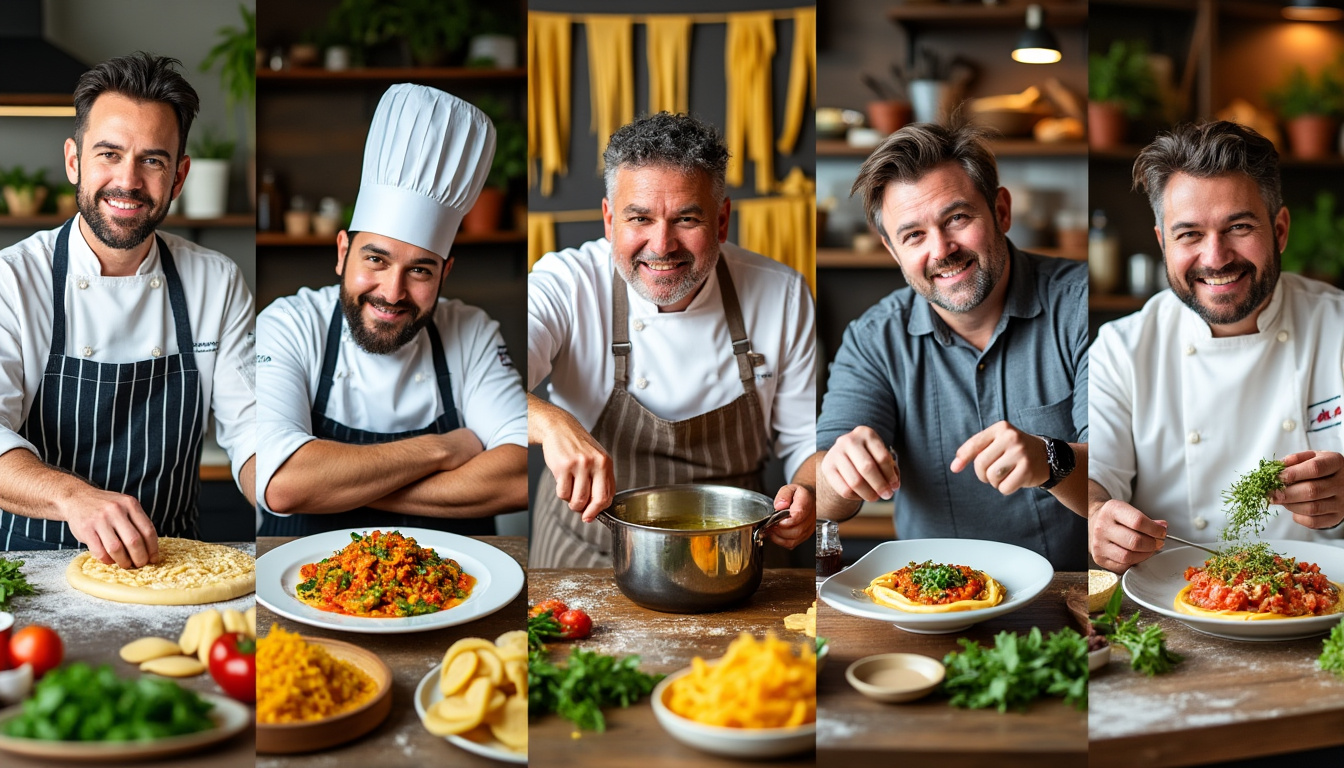pasta recipes: Five celebrated chefs reveal comfort pasta recipes and a shared trick — essential pasta recipes for weeknights, dinner parties and silky sauces.
Five renowned chefs shared their go-to pasta recipes for comfort and celebration, and a clear consensus emerged: keep the pasta water. This opening summary highlights the common wisdom that transforms simple pasta recipes into restaurant-level dishes. Short, practical, and proven, the advice links tradition with modern home cooking and product choices that matter.
Pasta recipes chefs swear by and the one tip they all shared
Top chefs often return to humble pasta for comfort. Their pasta recipes range from seafood alle vongole to saffron ravioli, yet four of five repeated the same technical note: reserve pasta cooking water to build sauce emulsion and silkiness.
- Shared tip: Save a ladle of pasta water to finish the sauce — it binds oil, cheese and starch into a glossy coating.
- Comfort classics: Spaghetti alle vongole, Orecchiette con cime di rapa, Saffron ravioli, Spaghetti Aglio e Olio, Harissa & Boursin linguine.
- Tools chefs mention: a reliable saucepan, fine colander, and quality utensils from brands like All-Clad and Le Creuset.
| Chef | Signature pasta recipes | Key shared technique |
|---|---|---|
| Jack Stein | Spaghetti alle vongole | Reserve pasta water to finish the sauce |
| Chef Roberta | Orecchiette con cime di rapa | Toss pasta with greens and pasta water for coating |
| Will Hickton | Saffron ravioli with monkfish | Use pasta water to adjust velouté consistency |
| Connor Robson | Spaghetti Aglio e Olio | Pasta water helps emulsify oil and garlic |
| The Spice Kitchen team | Harissa & Boursin Linguine | Pasta water smooths the Boursin into a silky sauce |
Practical takeaway: when following any of these pasta recipes, pause before draining — reserve water, then combine hot pasta and sauce to complete the dish. This small habit elevates texture and mouthfeel.
Why reserved pasta water matters for your pasta recipes
Starch-rich pasta water acts as a natural emulsifier. When mixed with fat (olive oil, butter) and cheese, it creates a unified sauce that clings to each strand or shell.
- It corrects consistency without diluting flavor.
- It helps bind oil-based sauces to pasta shapes.
- It prevents dry, clumpy pasta by adding controlled moisture.
| Problem | How pasta water solves it |
|---|---|
| Broken sauce separation | Emulsifies oil and cheese with starch for stability |
| Dry pasta | Adds silkiness and sheen without extra fat |
Key insight: mastering this single step multiplies the impact of any of the featured pasta recipes.
Technique and equipment: tools that make pasta recipes reliable
Reproducible results come from technique plus consistent equipment. The chefs named certain brands and tools repeatedly when describing what they trust in their home kitchens.
- Mixers and pasta machines: a stand mixer or a hand-crank from KitchenAid or a traditional Marcato for fresh dough.
- Cookware: heavy-bottomed pans like All-Clad or enameled pots from Le Creuset for even heating.
- Finish and serve: non-stick skillets such as Calphalon, quality olive oil like Bertolli, and jarred sauces from Rao’s Homemade for pantry backups.
- Retail sources: specialty shops like Williams Sonoma carry pro-grade items recommended by chefs.
| Task | Recommended tool/brand | Why it helps |
|---|---|---|
| Mixing pasta dough | KitchenAid or Marcato | Consistent elasticity, less fatigue |
| Even simmering | All-Clad or Le Creuset | Stable temperature, prevents scorching |
| Finishing sauce | Calphalon skillet | Quick temperature response for emulsions |
| Pantry shortcuts | Rao’s Homemade, Bertolli | Quality base flavors when fresh ingredients are limited |
Practical note: a modest investment in one or two reliable pieces — a pasta roller and a heavy saucepan — yields better outcomes across diverse pasta recipes. This is a cost-effective way to cook like the pros.
Weeknight pasta recipes, special-occasion dishes and quick adaptations
Chefs balance complexity with time. The five pasta recipes can be adapted for fast weeknights or for a full, celebratory service. Here are concrete options and links to tested weeknight resources to help choose the right approach.
- For speed: Spaghetti Aglio e Olio — minimal ingredients, maximum technique. See quick ideas at quick weeknight recipes.
- One-pan comfort: use the harissa & Boursin recipe and adapt it to a one-pot method; more one-pot inspiration at best one-pot meals.
- Weeknight crowd-pleaser: store-bought pomodoro enhanced with reserved pasta water and a drizzle of high-quality olive oil like Bertolli. See weeknight dinner recipes.
- Effortless entertaining: saffron ravioli as a centerpiece; prep components ahead and reheat gently. Tips on effortless hosting at effortless dinner recipes.
- Meal prep friendly: make fillings or sauces in batches; see easy meal prep recipes for schedule ideas.
| Recipe | Time | Best when |
|---|---|---|
| Spaghetti Aglio e Olio | 10–15 min | Weeknights, pantry cooking |
| Harissa & Boursin Linguine | 20–25 min | Short dinner with bold flavors |
| Orecchiette con cime di rapa | 30–40 min | Traditional family meal |
| Saffron ravioli | 90+ min | Special occasions |
| Spaghetti alle vongole | 12–15 min | Seafood-focused comfort |
For cooks seeking more recipe variety, curated lists help expand the repertoire: easy recipes for home cooks, essential recipes chefs and budget-friendly ideas at recession recipes.
Insight: matching the recipe to time available and choosing one robust technique (reserve pasta water) ensures any dish on the table tastes intentional and finished.
Practical recipe checklist before cooking any pasta recipes
Consistency is made of small decisions. The checklist below helps avoid common pitfalls and replicate chef-level results at home.
- Salt the water generously (about 1 tsp per 600 ml) so pasta is seasoned from within.
- Time pasta to be slightly under packet instructions for finishing in sauce.
- Reserve at least one ladle of pasta water before draining.
- Use quality olive oil and correctly aged cheeses; brands like Bertolli and Rao’s Homemade are reliable for pantry support.
- Finish by tossing pasta and sauce over heat with reserved water until glossy.
| Step | Why it matters |
|---|---|
| Salt water | Seasons pasta internally |
| Undercook slightly | Allows final cooking in sauce for perfect al dente |
| Reserve pasta water | Creates emulsified, silky sauce |
FAQ
How much pasta water should be reserved?
Reserve about 100ml (one ladle) per 400g pasta; add more if sauce needs loosening. The precise amount depends on sauce thickness.
Can store-bought pasta sauces work with these techniques?
Yes. Quality jarred sauces such as those from Rao’s Homemade gain lift and creaminess when finished with pasta water and a splash of olive oil.
Which pasta recipes are best for beginners?
Start with Spaghetti Aglio e Olio or a simple tomato-and-burrata spaghetti. Both teach timing, oil temperature and finishing with pasta water.
Is fresh pasta always superior?
Fresh pasta changes texture and shortens cooking time. It shines in filled pasta like ravioli but dried shapes (from brands such as Barilla and De Cecco) offer consistency and convenience.
What small investments upgrade home pasta recipes most?
A pasta roller (e.g., Marcato), a heavy saucepan (All-Clad or Le Creuset), and good knives. These give control and reliability without requiring professional training.

